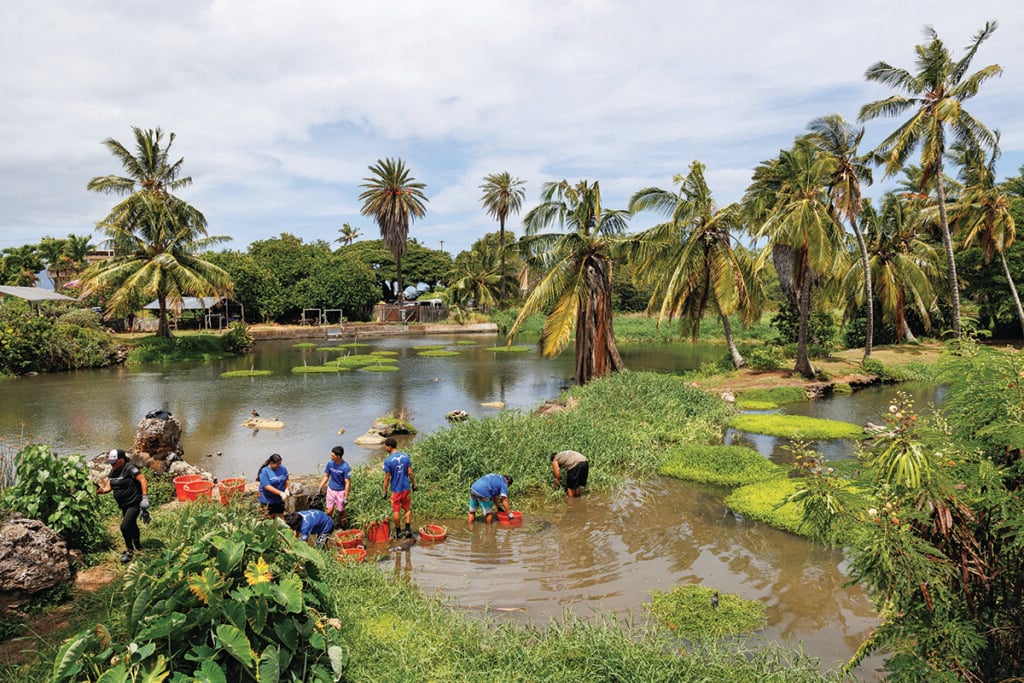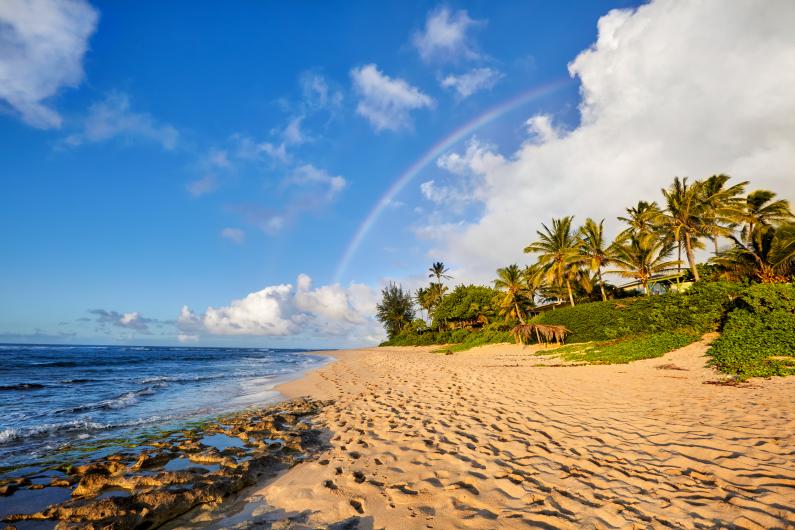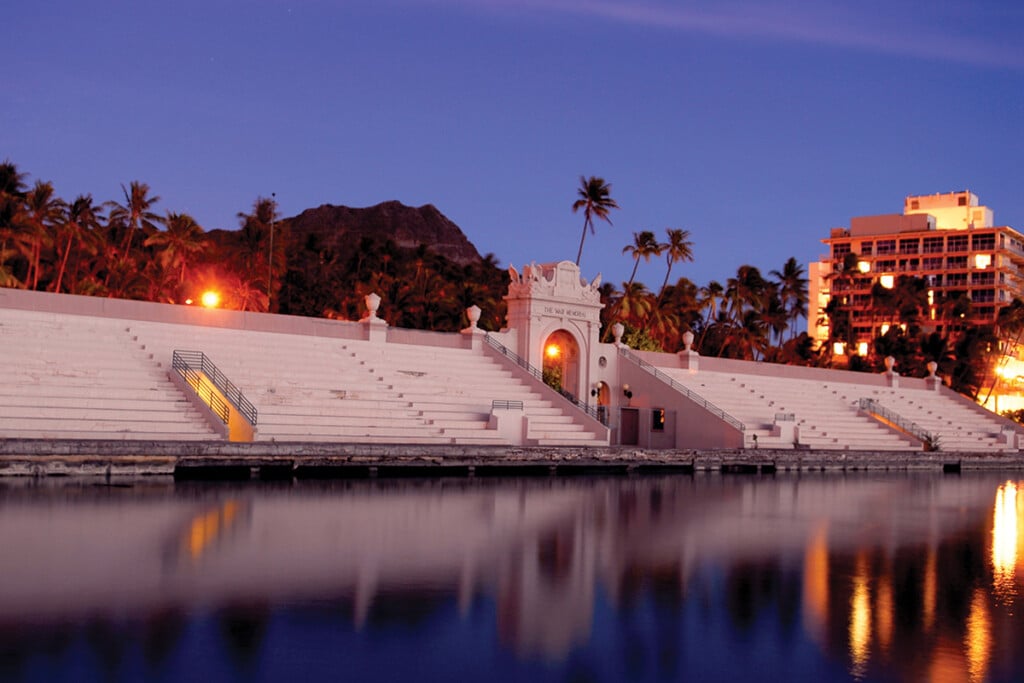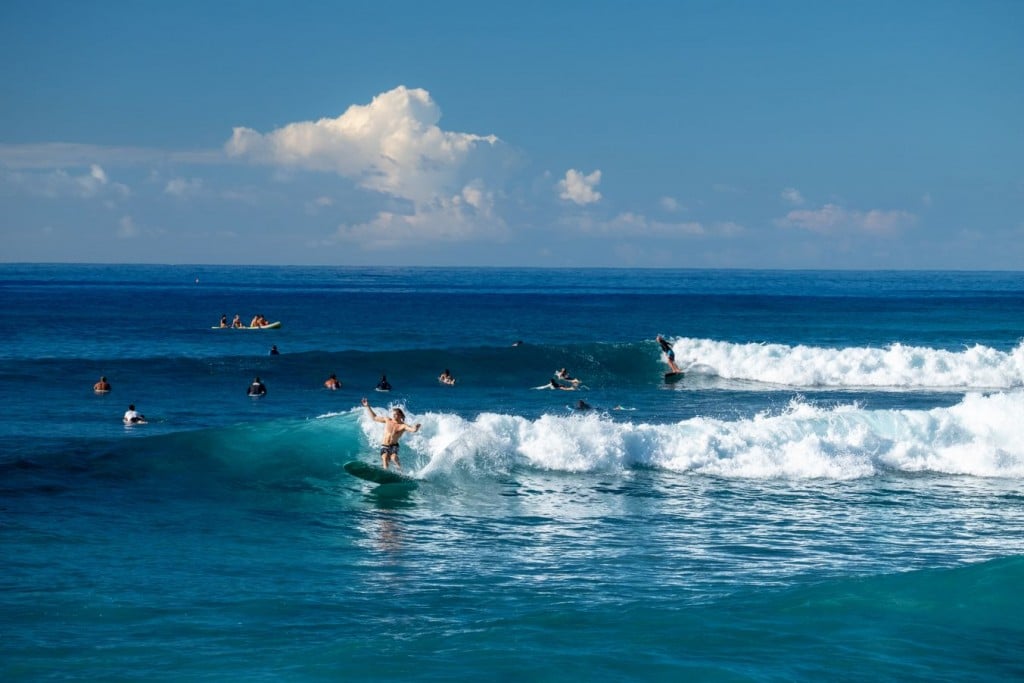Mālama: Cultural Connections at Loko Ea
Volunteer with Mālama Loko Ea, a nonprofit organization that’s restoring ancient fishponds on O‘ahu’s North Shore.

It’s 9 a.m. in Hale‘iwa on O‘ahu’s North Shore and surfers, paddlers and visitors are already hitting the beach and surf shops. But there’s another side to the world’s surfing capital: Tucked back from the main road, behind eateries and a row of palm trees, is the nonprofit Mālama Loko Ea, which has been restoring one of O‘ahu’s most abundant ahupua’a (a land division usually extending from the mountains to the sea) and loko pu‘uone (isolated fishponds near the shore that contain both fresh and salt water) for over 15 years.
Every third Saturday of the month Mālama Loko Ea hosts a community workday, with locals and travelers from all around the world joining in to help restore the land.
For generations—400 to 500 years ago—fishponds were part of the Native Hawaiian food system. They were either built in the ocean, or like the loko pu‘uone of Mālama Loko Ea, just short of the coast, with fresh water coming in from the mountains and a channel leading out to the ocean. Both utilize rock walls with sluice gates, or mākāhā, that allow baby fish to enter the pond, where they feed on vegetation and grow so large they can’t escape and are eventually harvested. The fishponds of Mālama Loko Ea, named Loko Ea and Ukoa, were built inland, out of the way of North Shore waves that can reach up to 50 feet.

A mākāhā (sluice gate) where the ocean water meets the fishpond.
Photo: Aaron K. Yoshino
Originally, Loko Ea and Ukoa were fed by spring water from the Ko‘olau Mountains, which flowed through the ponds and out to the ocean as part of the Kawailoa ahupua‘a. Today, they exist on legacy lands owned by Kamehameha Schools, safe from the commercial development that’s swallowed the surrounding area. Thanks to the community and founders of Mālama Loko Ea, James Estores and Benson W.K. Lee Jr., these ponds will eventually link back up with the mountain spring and reconnect the ahupua‘a—a project the organization predicts will take another 10 years to complete.
One of the challenges is keeping the ponds properly dredged. When the Hale‘iwa Boat Harbor was built in 1966, wave patterns in the area shifted. When the wind direction changes and the northern tide rises, sand is pushed into the channel that connects the fishponds to the ocean. The channel, which should be two to four feet deep, can be as little as 6 inches deep when that happens and needs to be shoveled out. The area around the mākāhā needs to be regularly shoveled out as well in order to maintain salinity and tidal flow exchange between ocean and fish pond. This is one of main tasks on volunteer workdays.
Another volunteer task involves the removal of invasive guinea grass that grows on land and along the ponds’ banks, crowding out and destroying native plants and ecosystems. Guinea grass can grow up to 10 feet high; it flourishes in Hawai‘i, so it’s imperative to keep a constant watch on it. After it is removed, the grass is used to create weed mats, mulch and chicken feed.

The fishpond holds monthly community workdays for volunteers.
Photo: Aaron K. Yoshino
A task that might take Mālama Loko Ea staff a month to accomplish can be done by volunteers in just an hour, says volunteer coordinator Honu‘āina Nichols. “Loko Ea thrives when people are brought back as an integral part of a functioning ecosystem. Without people, our ecosystem is incomplete.”
Last year, the organization purchased a dredge machine to essentially vacuum the bottom of Loko Ea to get it to the proper depth of 5 to 6 feet. The sediment gets redistributed along the banks of the fishpond.
Once complete, the next task is to rebuild its historic surrounding rock wall and five mākāhā. Only then can the pond become fully functional, producing what executive director Rae DeCoito estimates will be 500 pounds of fish per acre, per year.

Learn about fishponds and Hawaiian history and culture at community workday events.
Photo: Aaron K. Yoshino
As a traveler, one of the most intimate ways to learn about a new place is by volunteering with an environmental organization. You’ll learn about what makes the land thrive and what makes it languish, and about local and Indigenous cultures and customs. Each Mālama Loko Ea workday begins with a Hawaiian oli, or chant, through which staff and volunteers are introduced to the land and seek permission to enter it, just as people would do if they were arriving at someone else’s home. From a cultural perspective, many Native Hawaiians see themselves as children of the land and feel it is their responsibility to take care of it; in turn the land takes care of them. Participating in a workday and learning about Hawai‘i’s cultures and customs will change your perspective as a visitor on Hawaiian land. By caring for the land you’ll learn to value and respect it as if it were another human being.
“Every time we engage with ‘āina (land) our connection [to it] grows and our understanding of [that] connection roots deeper,” Nichols says. “Having a connection to ‘āina makes it personal when something happens to that space.”
Volunteer workdays are every third Saturday of the month. 62-540 Kamehameha Highway, Hale‘iwa, (808) 637-3232, @lokoeafishpond. Register online at lokoea.org.
This story was originally published in our Fall 2024 issue, which you can buy here. Better yet, subscribe and get HAWAIʻI Magazine delivered to right to your mailbox.


